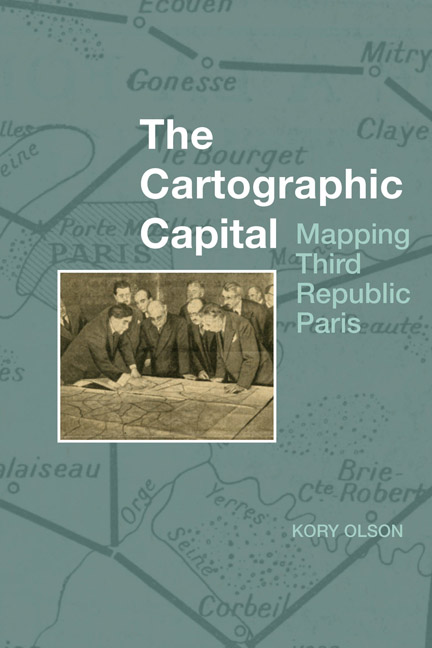Book contents
- Frontmatter
- Contents
- List of Figures
- Acknowledgements
- Introduction: Creating Republican Paris
- 1 Working with Maps
- 2 Creating Map Readers: The Rise of Geography and Cartography in Nineteenth-Century France
- 3 The Triumphant Republic: ‘Paris en 1889, les opérations de voirie exécutées entre 1871 et 1889’
- 4 A New Way of Seeing Paris: The Service Géographique's Carte de France
- 5 The Beginning of French Urbanism: Léon Jaussely's 1919 Plan d'extension
- 6 The Rise of Suburban Paris: Henri Prost's Carte générale
- Conclusion
- Bibliography
- Index
5 - The Beginning of French Urbanism: Léon Jaussely's 1919 Plan d'extension
- Frontmatter
- Contents
- List of Figures
- Acknowledgements
- Introduction: Creating Republican Paris
- 1 Working with Maps
- 2 Creating Map Readers: The Rise of Geography and Cartography in Nineteenth-Century France
- 3 The Triumphant Republic: ‘Paris en 1889, les opérations de voirie exécutées entre 1871 et 1889’
- 4 A New Way of Seeing Paris: The Service Géographique's Carte de France
- 5 The Beginning of French Urbanism: Léon Jaussely's 1919 Plan d'extension
- 6 The Rise of Suburban Paris: Henri Prost's Carte générale
- Conclusion
- Bibliography
- Index
Summary
Pour la première fois une revue française ouvre une chronique de l'Urbanisme. La Vie Urbaine ne pouvait manquer de prendre cette initiative: créée par le Conseil municipal de Paris pour l’étude méthodique des phénomènes qui président à la formation originelle des agglomérations, puis à leur développement […]. Dans l'ordre des recherches scientifiques, le champ de l'urbanisme est très vaste; n'en étant qu'au prémisses, cette science a devant elle un avenir étendu; dans l'ordre des réalisations pratiques où l'on cherche à appliquer les données de la science à la construction des agglomérations modernes, l'horizon, par le fait de la guerre, s'est singulièrement élargi.
—Léon Jaussely, Architecte en Chef du Gouvernement, editorial for the inaugural edition of Urbanisme (1919)As Paris entered the twentieth century, politicians and leaders from suburban communities increasingly articulated their dislike of the Paris-centric administration of the Seine department. Albert Thomas, former Undersecretary of War and mayor of Champigny from 1912 to 1919, perhaps best articulated the growing city-suburb divide. In his preface to a 1920 government report, Thomas spoke out against the economic segregation between the two sides. While the suburbs gained many new residents from rural France, they also accumulated costs associated with housing, caring for, and educating them. The factories, workshops, and stores that employed the newcomers, however, sent their taxes to Paris, where they usually remained (5). He called for more attention and development across the entire department, especially in suburban communities that experienced the most growth. In many respects, Thomas was right. Between 1872 and 1911, the city and adjacent Seine department gained over a million new residents (Wolf 17). Neighbouring departments also grew considerably in the first four decades of the Third Republic. In the 1911 census, the Seine-et-Oise claimed over 818,000 residents and the once-rural neighbouring Seine-et-Marne to Paris's east was home to 364,000 people. Now suburban communities needed to cooperate with Paris, boxed in by an outdated wall, to look for efficient and effective ways to administer, control, and plan for the region.
As the Paris Basin become more crowded, changing ideas of urban environments, championed by the Musée social movement plus the creation of the Société française des Urbanistes along with the subsequent École des hautes études urbaines, altered how government officials viewed the region.
- Type
- Chapter
- Information
- The Cartographic CapitalMapping Third Republic Paris, 1889-1934, pp. 175 - 220Publisher: Liverpool University PressPrint publication year: 2018



